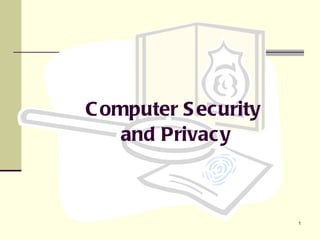
Computer security and_privacy_2010-2011
- 1. Computer Security and Privacy
- 18. Password Protections Average Time to Discover Number of Characters Possible Combinations Human Computer 1 36 3 minutes .0000018 seconds 2 1,300 2 hours .00065 seconds 3 47,000 3 days .02 seconds 4 1,700,000 3 months 1 second 5 60,000,000 10 years 30 seconds 10 3,700,000,000,000,000 580 million years 59 years
- 33. Did You Know? The penalty for copying software can be up to $250,000, five years in prison , or both?
Hinweis der Redaktion
- Both hackers and crackers have advanced computer and network skills
- Example: The extensive damage might destroy the nation’s air traffic control system, electricity-generating companies, or a telecommunications infrastructure. The more common computer securityb risks include Internet theft, network attacks, unauthorized access, and use, hardware theft, software theft, information thft, and system failure.
- Every unprotected computer is susceptible to these computer security risks: computer virus; worm; Trojan Horse Once the virus infects the computer, it can spread throughout and may damage files and system software, including the operating system. Worm example: in memory or on a network , using up resources and possible shutting down the computer or network Trojan horse – a certain condition or action usually triggers the Trojan horse. Unlike a virus or worm, a Trojan horse does not replicate itself to other computers
- Unscrupulous programmers write malware and then test it to ensure it can deliver its payload.
- Many programs allow a user to preview an e-mail message before or without opening it. Thus you should turn off message preview in your e-mail program. Virus hoax – an e-mail message that warns users of a nonexistent virus, worm, or Trojan horse. Often, these virus hoaxes are in the form of a chain letter that request the user to send a copy of the e-mail messages to as many people as possible. Antivirus program—protects a computer against viruses by identifying and removing an y computer viruses found in memory, on storage media, or on incoming files. Most antivirus programs also protect against worms, Trojan horses, and spyware. Some viruses are hidden in macros, which are instructions saved in an application such as a word processing or spreadsheet program.
- Back Doors – once inside the software, they often install a back door or modify an existing program to include as back door, which allows them to continue to access the computer remotely without the user’s knowledge. Spoofing – Perpetrators trick their victims into interacting with a phony Web site. The victim may provide confidential information or download files containing viruses, worms, or other malwar fooling another computer by pretending to send packets from a legitimate source e.
- Software requires the expertise of a network administrator because the programs are complex and difficult to use and interpret. These programs are expensive.
- a mini-security system -- shuts down the computer and sound an alarm if the computer is moved outside a specified distance License agreement—is the right to use the software
- System failure– can cause loss of hardware, software, data, or information. UPS – advice the contains surge protection circuits and one or more batteries that can provide power during a loss of power. A ups connects between your computers and a power source.